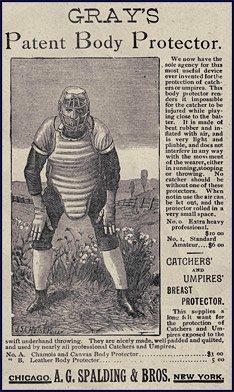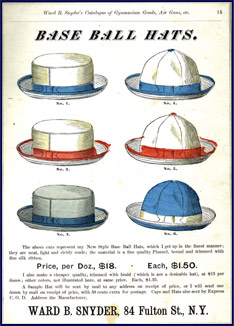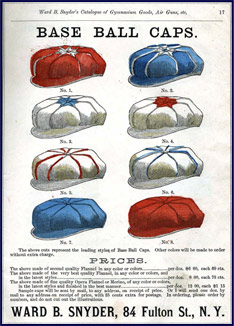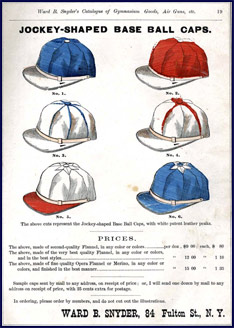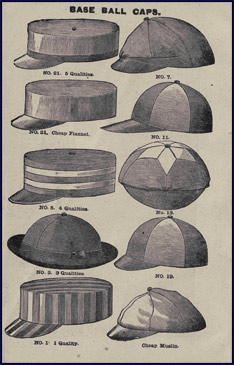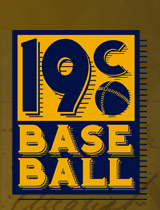Evolution of Baseball Equipment (Continued)
The Baseball
By Eric Miklich

he baseball was a very important part of the development of the early game of baseball. The hand-made baseball allowed their makers to become identified as making a "live," "medium" or "dead" ball and added to the strategy employed by visiting teams. The size and weight of the baseball changed radically in 1857, continued to change in the 1860's and in 1872 became the same as the ball used today.
Early baseballs were made simply by surrounding a core, which could be any solid substance, with hand wound yarn or string. Often times the baseball would also contain some form of stuffing. The cover was a one piece cover, usually some form of brown leather, which was stitched in a fashion known as a "lemon peel" or "rose pedal." The four sides of the single piece of leather were sewn to enclose the baseballs core and the stitching formed an "X" configuration. These early base balls were extremely light and soft and prior to 1845 runners were allowed to be "soaked" or hit with a thrown ball as a way to be put out.
With all baseballs being hand made by players and local merchants there was no standard size or weight. From 1845 - 1853 "unofficially" most balls were quite small as compared to today's model and were considerably lighter. The covers were now all made of leather and the shade varied from medium brown to dark brown. During an 1854 baseball meeting of three New York teams, the Knickerbocker, Gotham and Eagle clubs, a specific weight and circumference was decided upon. The ball was to be between five and one-half to six ounces in weight and be between two and three-quarter and three and one-half inches in diameter. The specifications agreed upon were certainly not the standard for the country and most likely were the dimensions from the balls that they were familiar with. These balls still consisted of a single piece of dark brown leather for the cover sewn, in the "lemon peel" fashion.
During the first baseball convention in 1857, which was held in New York at Smith's Hotel and attended by 15 New York clubs, the diameter of the baseball was voted on to be between ten and ten and one-quarter inches in circumference and weigh between six and six and one-quarter ounces.
In 1858, H.P. Harwood and Sons of Natick, MA (c/o North Avenue and Main Street) became the first factory to produce baseballs. They also were the first in the production of the two-piece figure-eight stitch cover baseball, the same that is used today. The figure-eight stitching was devised by Col. William A Cutler and a new wound core was developed by John W. Walcott, horsehide and then cowhide were used for the cover.
It has been written that Ellis Drake was the inventor of the two-piece figure-eight stitched baseball cover. Drake was born in 1839, in Stoughton, MA and was the son of a shoemaker. He is said to have sketched the design for the two-piece cover in school in the 1840's and made a prototype from his father's scrap leather. He stated that the lemon peel balls used at school where "round ball" was played came apart on the four corners and caused the ball not to be true when thrown. According to Drake, two years after he made the ball, George and Harry Wright began making baseball covers like Drake's and selling them. Ellis Drake died on December 18, 1912, never patenting his idea.
During the second baseball convention in 1858, specific rules for the composition of the ball were first described. The core was to be india-rubber, wrapped with yarn and covered in leather. India-rubber comes from the latex of many tropical plants and is very elastic. The rules also stated that the ball was to be furnished by the challenging club and presented to the winning club as a trophy, which was the accepted custom. All baseballs were hand made by members of the team or by local merchants. Each baseball maker had a certain style ball that they produced and this was determined by the reaction of the ball when hit or when the ball bounced off of the playing field. A ball maker that used larger amounts of rubber for the core and was tightly wound, translated to a "lively" baseball and a maker who used less rubber for the core and did not wind the ball very tight with yarn, tended to make a "dead" baseball. A "medium" ball had a core of about one and half ounces and was wound fairly tightly.
One of the first famous baseball producers was Harvey Ross, who was a sail maker and member of the Atlantic Club of Brooklyn. He operated his business from 224 Park Avenue, Brooklyn, New York. The Atlantics favored his baseball and he eventually sold his product all of the country. The Ross ball generally contained only 1½ ounces of rubber and was considered a dead ball. Ross made sure that all of his baseballs had his trademark stamp on them and his symbol was a cap in the center of a circle with a star on either side of it with the words "Harvey" on top and "Ross" on the bottom. He also stamped the weight and size of the ball on the cover. Dark leather was used not only by Ross but by other baseball makers because it was easier for the players to see when the ball was hit in the air on a clear day.
In 1860 the dimensions agreed upon during the yearly convention were changed and the new playing rules stated that the weight of the ball should be between five and three-fourths ounces and between nine and three-fourths to ten inches in circumference. The ball was still to be made of india-rubber, wrapped in yarn and covered in leather. The leather was still brown and the shade varied depending upon what leather was available to the craftsman. John Van Horn, second baseman for the Baltic Club of New York, in the 1850's, was the leading produce of baseballs in the early 1860's. Van Horn, who was a shoemaker, was located at 33 Second Avenue in New York and used rubber from old shoes to comprise the core of his baseballs. He used between 2 and 2½ ounces of rubber in baseball, which translated in to a "lively" ball and used sheepskin for the cover. He supplied the Knickerbocker Club and has been dubbed the "greatest ball maker of the 19th century."
